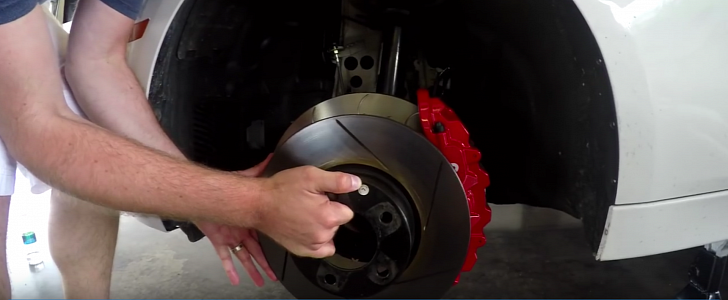If you want to take your car to a local track every other day, you should know that a standard model will rarely cut it, and after a couple of laps, you will probably end up with no brakes and no tires. Of course, there are some exceptions to the rule, but those wear the M badge and are not available just for anyone.
Chances are you might be the owner of a car more like the 328i, for instance, and that means the following guide will be of serious help to you. That’s because the guys from Drive have used such a model to learn what the best way to upgrade your ride is without overspending or throwing your money away.
The most important upgrade you’ll want to consider before going for a full track day is the braking factor. However, that doesn’t mean just the brakes themselves, but the whole complex system that brings you to a halt. That includes tires and wheels.
In this regard, you might want to go for a separate set of wheels. The stock run flat tires BMW provides won’t cut it as they are too hard and too expensive to be used on a track. Furthermore, you might want to use lighter wheels to allow your car to stop faster (having less weight to spin and stop makes for more efficient braking).
A complete set of wheels with proper racing tires is recommended, as they need to make good contact with the road. Then comes the technical part.
Upgrading the brakes can be done in a variety of ways. You can change the pads, the rotors, the fluid or the entire setup with a big brake kit that includes calipers as well. Should you go for the full treatment?
Well, as you’re about to see, upgrading your pads makes a difference, but we didn’t expect them to make such a big one. The Hawk pads used first improved the stopping distance by quite an impressive figure.
Then it was time to test the better rotors and, surprise, surprise, they didn’t do a great job at improving the stopping distance. That’s because you need to get them up to a high temperature to work properly. Slotted rotors do a better job than stock ones because of those creases you see on them.
What they do is release the hot gas formed by the pads rubbing against the brake discs on the track. Therefore, the testing scenario chosen for them didn’t work as expected as they are better at higher temperatures.
Last but not least, a big brake kit from AP Racing was added to the mix, made up of a set of 370-mm rotors and a six-piston brake caliper up front and 360-mm rotors in the back with four-piston calipers. That’s an increase of 60 mm on both axles. This is also the sort of system you’d use on a full-on racing car.
As expected, the big brake kit made the most significant difference, but you don’t need to go the whole nine yards unless you plan on racing pretty often. For the best bang for your buck, you’d be better off with a proper set of pads and a brake fluid change.
The most important upgrade you’ll want to consider before going for a full track day is the braking factor. However, that doesn’t mean just the brakes themselves, but the whole complex system that brings you to a halt. That includes tires and wheels.
In this regard, you might want to go for a separate set of wheels. The stock run flat tires BMW provides won’t cut it as they are too hard and too expensive to be used on a track. Furthermore, you might want to use lighter wheels to allow your car to stop faster (having less weight to spin and stop makes for more efficient braking).
A complete set of wheels with proper racing tires is recommended, as they need to make good contact with the road. Then comes the technical part.
Upgrading the brakes can be done in a variety of ways. You can change the pads, the rotors, the fluid or the entire setup with a big brake kit that includes calipers as well. Should you go for the full treatment?
Well, as you’re about to see, upgrading your pads makes a difference, but we didn’t expect them to make such a big one. The Hawk pads used first improved the stopping distance by quite an impressive figure.
Then it was time to test the better rotors and, surprise, surprise, they didn’t do a great job at improving the stopping distance. That’s because you need to get them up to a high temperature to work properly. Slotted rotors do a better job than stock ones because of those creases you see on them.
What they do is release the hot gas formed by the pads rubbing against the brake discs on the track. Therefore, the testing scenario chosen for them didn’t work as expected as they are better at higher temperatures.
Last but not least, a big brake kit from AP Racing was added to the mix, made up of a set of 370-mm rotors and a six-piston brake caliper up front and 360-mm rotors in the back with four-piston calipers. That’s an increase of 60 mm on both axles. This is also the sort of system you’d use on a full-on racing car.
As expected, the big brake kit made the most significant difference, but you don’t need to go the whole nine yards unless you plan on racing pretty often. For the best bang for your buck, you’d be better off with a proper set of pads and a brake fluid change.

